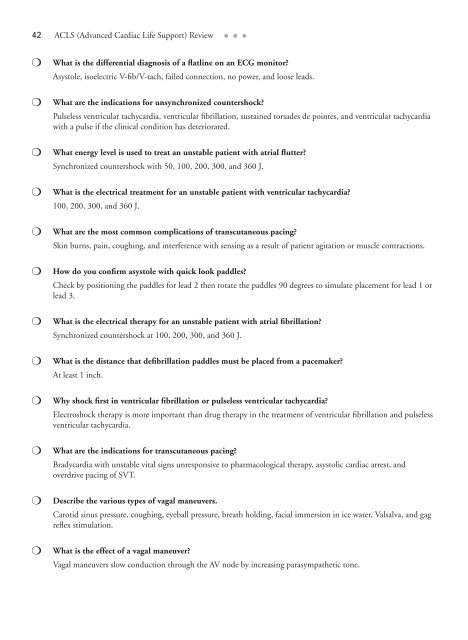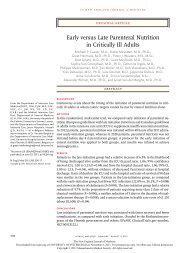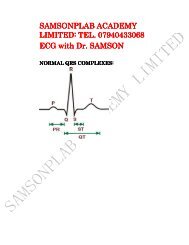ACLS Review
Create successful ePaper yourself
Turn your PDF publications into a flip-book with our unique Google optimized e-Paper software.
42 <strong>ACLS</strong> (Advanced Cardiac Life Support) <strong>Review</strong> ...<br />
❍<br />
❍<br />
❍<br />
❍<br />
❍<br />
❍<br />
❍<br />
❍<br />
❍<br />
❍<br />
❍<br />
❍<br />
What is the differential diagnosis of a flatline on an ECG monitor?<br />
Asystole, isoelectric V-fib/V-tach, failed connection, no power, and loose leads.<br />
What are the indications for unsynchronized countershock?<br />
Pulseless ventricular tachycardia, ventricular fibrillation, sustained torsades de pointes, and ventricular tachycardia<br />
with a pulse if the clinical condition has deteriorated.<br />
What energy level is used to treat an unstable patient with atrial flutter?<br />
Synchronized countershock with 50, 100, 200, 300, and 360 J.<br />
What is the electrical treatment for an unstable patient with ventricular tachycardia?<br />
100, 200, 300, and 360 J.<br />
What are the most common complications of transcutaneous pacing?<br />
Skin burns, pain, coughing, and interference with sensing as a result of patient agitation or muscle contractions.<br />
How do you confirm asystole with quick look paddles?<br />
Check by positioning the paddles for lead 2 then rotate the paddles 90 degrees to simulate placement for lead 1 or<br />
lead 3.<br />
What is the electrical therapy for an unstable patient with atrial fibrillation?<br />
Synchronized countershock at 100, 200, 300, and 360 J.<br />
What is the distance that defibrillation paddles must be placed from a pacemaker?<br />
At least 1 inch.<br />
Why shock first in ventricular fibrillation or pulseless ventricular tachycardia?<br />
Electroshock therapy is more important than drug therapy in the treatment of ventricular fibrillation and pulseless<br />
ventricular tachycardia.<br />
What are the indications for transcutaneous pacing?<br />
Bradycardia with unstable vital signs unresponsive to pharmacological therapy, asystolic cardiac arrest, and<br />
overdrive pacing of SVT.<br />
Describe the various types of vagal maneuvers.<br />
Carotid sinus pressure, coughing, eyeball pressure, breath holding, facial immersion in ice water, Valsalva, and gag<br />
reflex stimulation.<br />
What is the effect of a vagal maneuver?<br />
Vagal maneuvers slow conduction through the AV node by increasing parasympathetic tone.







